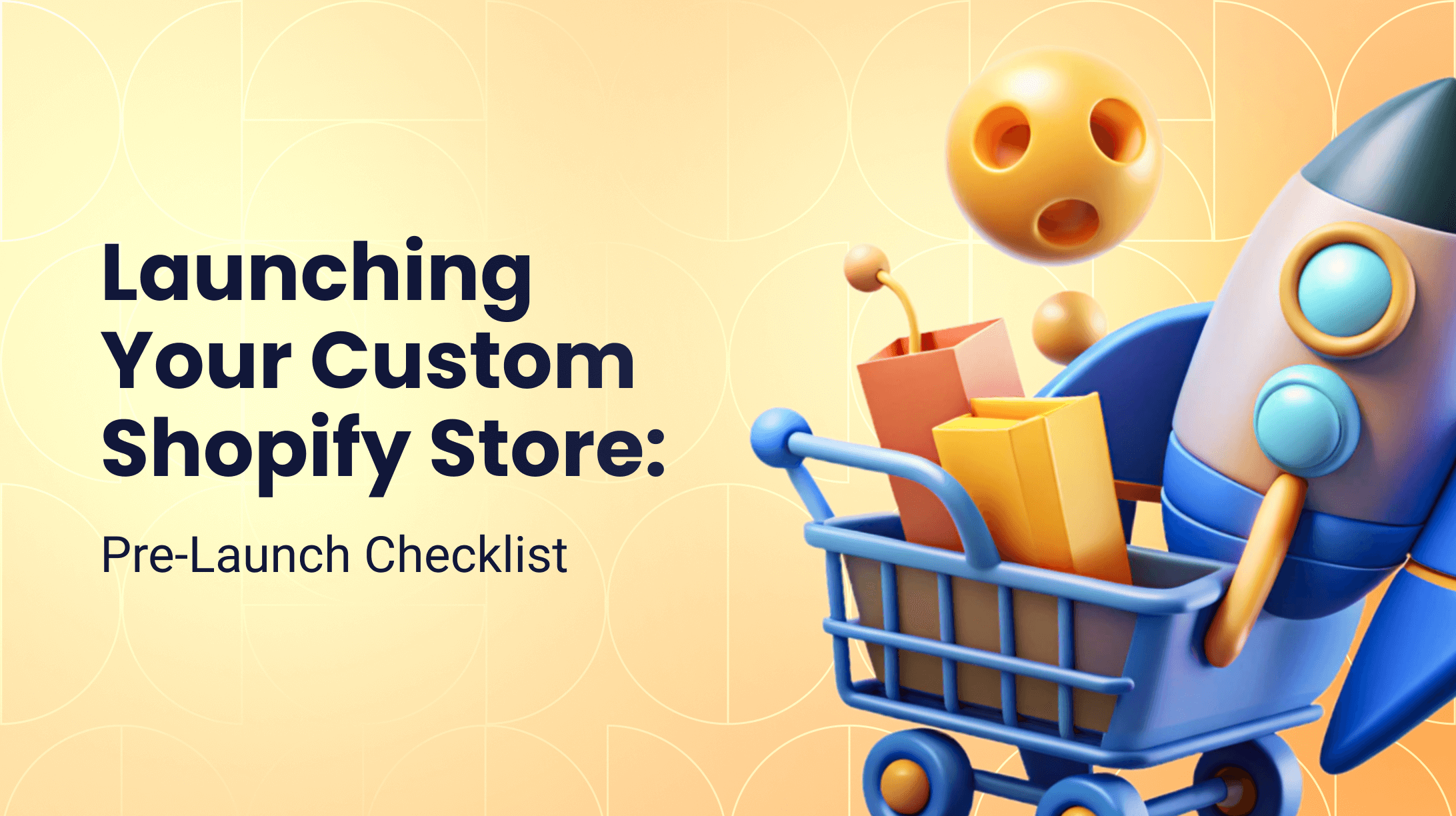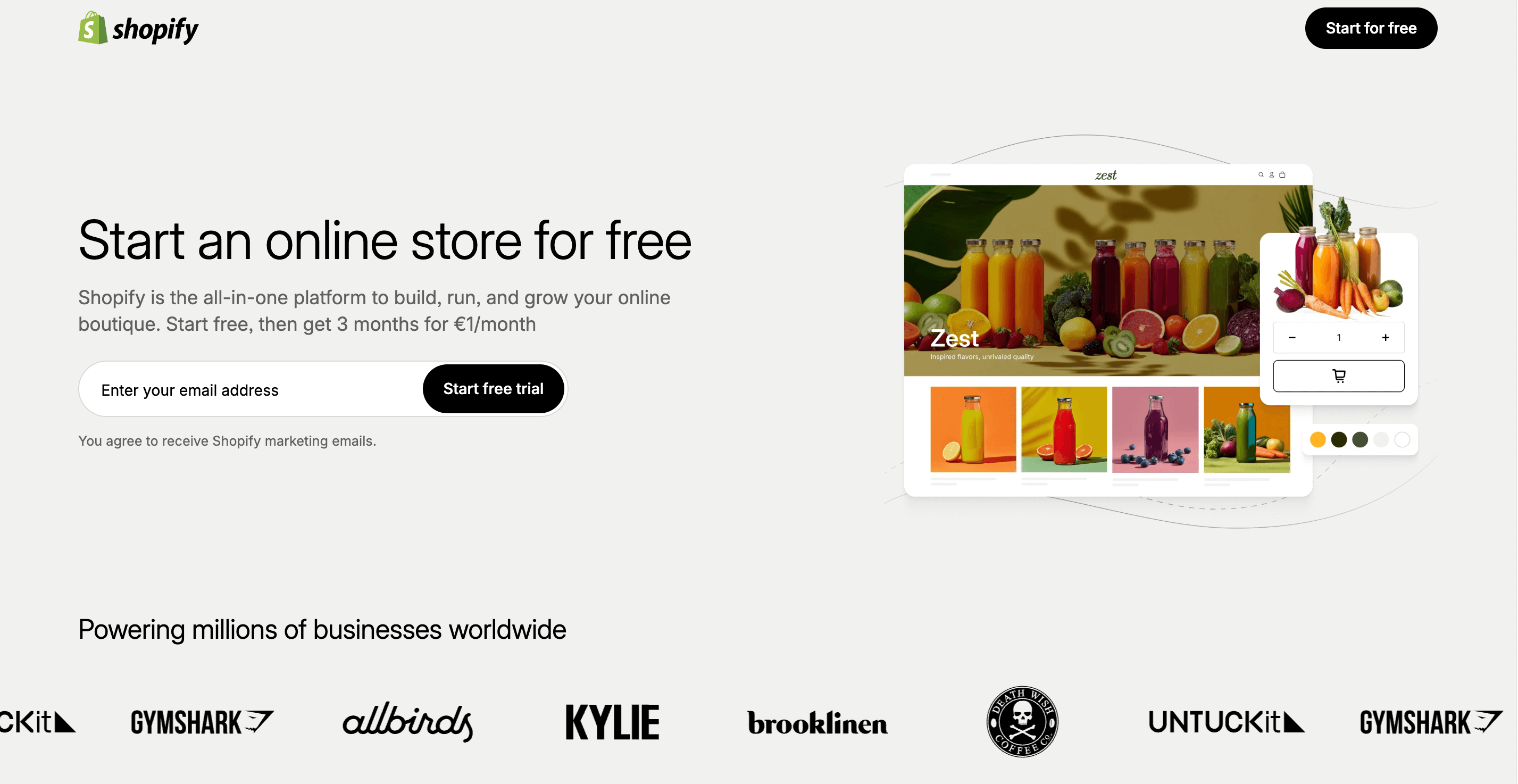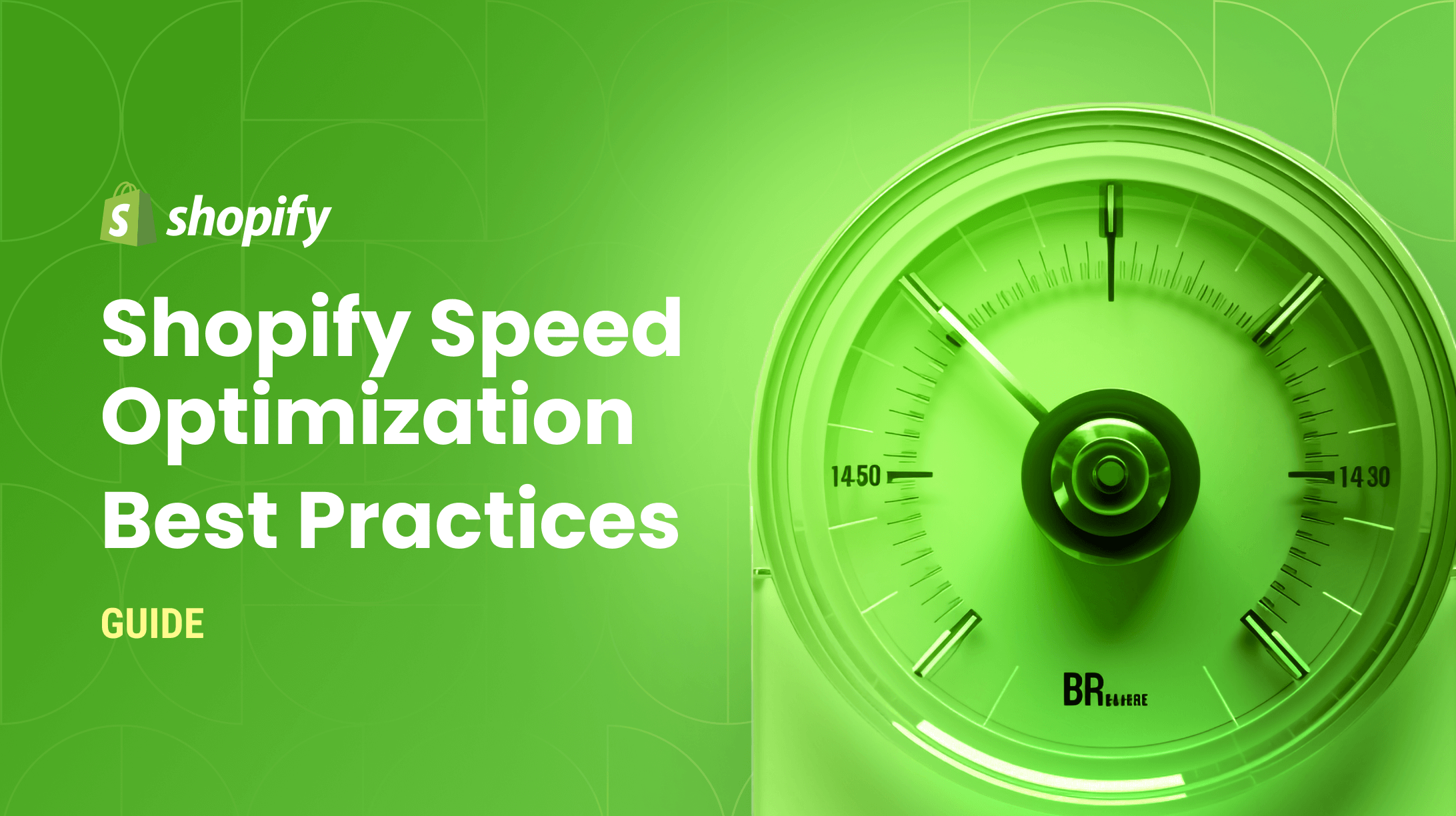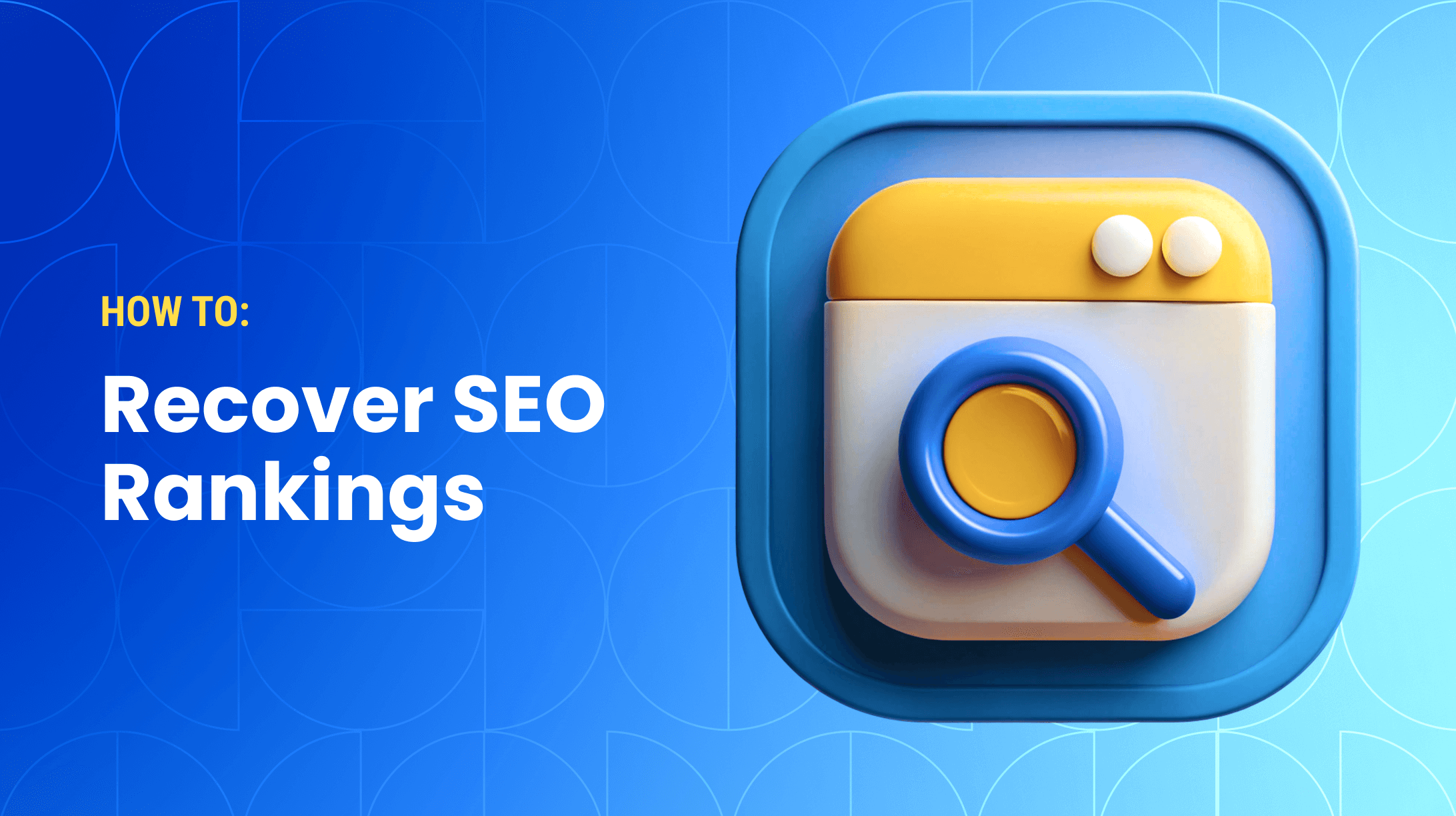-39%

The success of an e-commerce store hinges on meticulous testing, strategizing, and a commitment to post-launch evolution. That’s why a successful launch requires serious, expert-level Shopify website development and planning.
This article serves as a guide that provides the best practices as well as offers a comprehensive pre-launch checklist, tailored to ensure a confident start for any Shopify-powered e-commerce business.
How to Start a Shopify Store?
A successful Shopify launch extends far beyond simply making a store "live." It requires a strategic foundation built on deep research and clear planning. As you begin this critical phase, consider the following key aspects to ensure a focused and impactful market entry:

Clear Objectives
Define your goals with precision, going beyond revenue targets. Most successful e-commerce ventures attribute their achievements to well-defined objectives, which proves the importance of having a focused and purposeful launch strategy. Consider factors like customer engagement, brand visibility, and user experience.
Audience Analysis
Delve into the detailed audience demographics to understand not just who they are, but what influences their purchasing decisions. According to Zendesk’s study, tailoring your website to meet the expectations of your target demographic leads to a 68% higher customer satisfaction rate.
Strategic Timeline
Develop a timeline that considers not only the overall project deadline, but also individual milestones. This rigorous scheduling contributes to the project's overall success.
Pricing Strategy
Develop a Shopify pricing model that reflects your brand's value, covers costs, and aligns with your target market's expectations. Your strategy should be more than just cost-plus: consider perceived value, competitor pricing, and psychological pricing tactics to optimize for conversion and profitability from day one.
Market Nuances
Identify unique market nuances that can shape your store's offerings. Uncover gaps or opportunities that set your store apart from the competition. Hanover Research says that businesses that invest in understanding market nuances see a 76% higher revenue in the span of 12 months.
Shopify Customization Best Practices
Customizing your Shopify store goes beyond aesthetics. You need to create a digital experience that truly resonates with your brand and captivates your audience.
First, aim to launch a Shopify theme that is responsive. Mobile compatibility is not only about accommodating smartphone users but is a critical factor affecting your search engine rankings. Google considers mobile-friendliness a ranking factor, and SEO is a sphere you can't afford to overlook.
View your website's design as a critical business investment. A polished interface can boost conversion rates by up to 200%, while a visually unappealing site may cause nearly 40% of visitors to leave. Combining strong design with intuitive navigation captures attention and guides it effectively, creating a user experience that drives growth and fosters loyalty.
Once you’ve chosen a theme, delve into layout customization and tailor your store to match your brand identity. To extend your store's core functionality, carefully select essential apps for marketing, analytics, and customer service. Consider the following best practices for Shopify store customization:
- A/B Testing – Experiment with different elements on your site to identify what resonates best with your audience.
- Loading Speed Optimization – Users expect a page to load within two seconds, and even just a 1-second delay in page response can result in a 7% reduction in conversions. Leverage browser caching and invest in a reliable hosting infrastructure.
- Interactive Features – Implement engaging features like product demos or virtual try-ons. According to DC Creative Partners, interactive content generates 86% more conversions than static content.
- Scalability – Design your customization with scalability in mind. Your Shopify store should seamlessly accommodate increased traffic and product offerings as your business grows.
Remember that customization is an ongoing process. Regularly revisit and update your store to align with evolving trends and user preferences.
Testing Your Shopify Store Before Launch
A thorough testing phase is very important for a successful Shopify launch. It ensures a flawless customer experience, builds trust, and protects your sales. A systematic approach helps you identify and fix issues before they impact real users.
We recommend categorizing your testing into three key areas: Functionality, Performance, and Compatibility. Use the following checklist as a comprehensive guide to ensure no critical test is missed.
| Category | What to Test | Key Actions & Goals |
Functionality | Product Catalog | Verify all product variants, prices, and images display correctly. Test image zoom, gallery navigation, and ensure fast loading. Check that inventory levels update accurately. |
| Shopping Cart & Checkout | Test adding/removing items and updating quantities in the cart. Go through the entire checkout flow as a customer. Ensure discount codes, shipping rules, and taxes calculate correctly. | |
| Payment Gateways | Place test orders using all enabled payment methods (e.g., Shopify Payments, PayPal, etc.). Confirm order confirmation emails are sent successfully. | |
| Performance | Page Load Speed | Aim for a load time of under 2 seconds for all key pages. Optimize images, leverage browser caching, and minimize app code. Use tools like Google PageSpeed Insights or GTmetrix. |
| Stress & Load | Simulate high traffic to see how your store performs under pressure. Identify bottlenecks that could cause the site to slow down or crash during a sale or promotion. | |
| Compatibility | Cross-Browser | Test on major browsers: Chrome, Firefox, Safari, and Edge. Ensure consistent layout, functionality, and rendering. |
| Mobile Responsiveness | Navigate the entire site on various smartphones and tablets. Confirm that menus, buttons, and forms are easy to use on touchscreens. Ensure text is readable and no horizontal scrolling is required. |
By investing time in this structured testing process, you significantly reduce the risk of post-launch issues. The speed and performance of your Shopify store, along with its functional reliability, are critical to success. This comprehensive approach not only safeguards your revenue and brand reputation but also enhances the overall reliability and performance of your store from the moment you go live.
Pre-Launch Shopify Checklist
Before your custom Shopify store goes live, following this Shopify store launch checklist is a critical step to ensure a seamless customer experience and operational efficiency. We have broken this down into the following 8 essential steps for a comprehensive launch plan. Follow this step-by-step guide to ensure nothing is overlooked before you go live:
1. Finalize Product Information and Images
The devil is in the details. Validate product descriptions, ensuring they align with Shopify SEO best practices. High-quality product images matter as they can boost conversion rates.
2. Set Up Shipping and Tax Settings
Navigate the complexities of shipping by configuring accurate rates. More than half of all abandoned carts are due to unexpected costs like shipping and taxes. Therefore, transparency here is more than a best practice but a conversion strategy.
3. Configure Payment Gateways
Diversity matters, and offering multiple payment options can increase conversion rates, especially if you’re targeting a global audience of customers. Strategically align your payment gateways with your potential clients’ preferences.
4. Secure Your Store with SSL
Online shoppers avoid unsecured websites. What’s more, even if people wouldn’t mind visiting risky websites, most up-to-date browsers won’t let users proceed to unsafe stores. Secure your store with a proper SSL certificate to instill confidence both in your future customers and their browsing software.
5. Implement Analytics and Tracking Tools
Knowledge is power: 52% of businesses leverage advanced and predictive analytics. Integrate robust analytics tools to monitor user behavior, track conversions, and fine-tune your strategy based on real data.
6. Test Transactional Emails
Transactional emails are a powerful touchpoint that arrives when users are most engaged. Messages like order confirmations are expected and sought out, which guarantees a captive audience. Ensure these communications are flawless and consistently reflect your brand voice. A well-crafted transactional email can transform a routine notification into a moment of trust and a seamless brand experience.
7. Create a 404 Error Page (and Handle Other Errors)
Plan for the unexpected. Craft a user-friendly 404 error page, and identify potential issues. A seamless error-handling system can effectively retain potentially lost customers.
8. Implement Legal Requirements (Terms of Service, Privacy Policy, etc.)
Legality is non-negotiable. But apart from compliance, transparent legal documentation builds trust, as consumers are more likely to trust a business with comprehensive legal policies. Make sure to not only create all the necessary pages but also make them easy to find on your store.
Launching Your Shopify Store
As you approach the final stages of your Shopify store development, your ‘how to launch a Shopify store’ questions start to focus more on the time aspect. The moment of launch not only marks the introduction of your online presence but also sets the tone for customer reception and business trajectory in the future. Here are some additional tips for this step:
Announcing the Launch
Announce the launch strategically, since an effective approach can significantly impact initial traction and engagement. While it's tempting to rely solely on digital channels, consider a multichannel approach for broader reach. Social media, with its vast user base, has proven instrumental in driving initial traffic.
Initial Hours and Monitoring
During the initial hours, monitor crucial metrics to ensure everything runs smoothly. Keep a close eye on page load times to maintain a positive user experience, and identify where your traffic is coming from to ensure the success of your future marketing campaigns.
Server and Traffic
Make sure your server can handle the influx of visitors and have a robust customer support system in place. Downtime can be detrimental but unavoidable. Responding promptly to user queries or concerns can salvage potentially lost transactions.
Set Up Your Shopify Store With Transform Agency
The launch of your custom Shopify store is not a standalone event, but a process that extends into the post-launch phase. A well-executed launch, coupled with active monitoring and rapid issue resolution, positions your e-commerce venture for sustained success.
Try to see the post-launch phase as an opportunity for continuous improvement. Leverage analytics to decipher user behavior, use customer feedback as a compass, and iteratively refine based on data-driven decisions. Your commitment to this comprehensive process will shape a lasting and successful Shopify business.
FAQ
How to launch a Shopify store?
Launching a Shopify store involves a structured process: First, select a plan and a custom domain. Then, customize your store's design, add your products, and configure settings for shipping, taxes, and payments. Finally, rigorously test everything (from the checkout process to site speed) before you remove the password and go live.
How long does it take to build and launch a Shopify store?
A basic store can be launched in a single day. A more polished, professional store typically takes a few days to a few weeks to build and launch.
How do I preview my Shopify store before launch?
While building your store, it is automatically password-protected. You can view and navigate the live site using this password to see exactly how it will look to customers.
How to test Shopify store before launch?
Use a test payment gateway in your checkout settings. This allows you to place fake orders to ensure the entire purchasing process, from cart to confirmation, works correctly.
With 7 years of experience in the IT industry, Yaroslav specializes in e-commerce solutions. He has developed approximately 15 online stores, ranging from medium-sized shops to large marketplaces, gaining extensive experience across various industries including financial services, retail & distribution, and life sciences & healthcare. Skilled in Adobe Commerce, he excels in frontend development solutions for this CMS.
With 7 years of experience in the IT industry, Yaroslav specializes in e-commerce solutions. He has developed approximately 15 online stores, ranging from medium-sized shops to large marketplaces, gaining extensive experience across various industries including financial services, retail & distribution, and life sciences & healthcare. Skilled in Adobe Commerce, he excels in frontend development solutions for this CMS.



